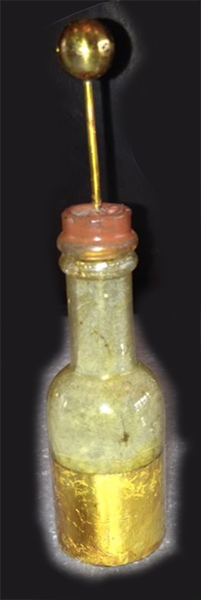"Very simply: it is a glass jar that has a metallic coating on both sides of the glass. Named for the Dutch city of Leiden (originally spelled “Leyden”) in South Holland where it was discovered, the Leyden Jar is the earliest form of a capacitor, an electronic component in all modern circuitry. It works by holding an electric charge in the space between two conductive plates. This space between these plates is filled with a seemingly non-conductive material (which is called a dielectric) such as glass, plastic, or even paper. It is this separating material that is the key to understanding how the capacitor works. To modern eyes, the capacitor seems unremarkable; in fact, its discovery was a fundamental moment that ushered in a deeper understanding of the electromagnetic universe in which we live. The technologies developed from this knowledge (radios, computers, smart phones, etc.) have not only impacted our daily lives, but also are now helping us to explore our own galaxy."
Discovered twice, once by a Pomeranian cleric, Eward Georg von Kleist, and then by a Dutch scientist, Pieter van Musschenbroek, the Leyden Jar was able to store a substantial electrical charge to release it later. In the eyes of eighteenth century audiences, the Leyden Jar was an utterly thrilling discovery. [See for instance, Charles-Amédée-Philippe van Loo's painting of a salon Leyden Jar experiment. Note that although van Loo completed this painting in 1777, he depicts the jar in its earlier form sans metal foil.]
The Leyden Jar lead to an increase in the number of and attendance to electrical displays and as I address in the biography's appendix on glass technology, the fervor for electrical experimentation spurred glass manufacturing in the colonies.

The Leyden Jar continued to be used well into the late nineteenth century. It makes cameo appearances in both Jules Verne’s Twenty Thousand Leagues Under the Sea (Leyden bullets) and in Herman Melville’s Moby Dick: “It seemed as though, by some nameless, interior volition, he would fain have shocked into them the same fiery emotion accumulated within the Leyden jar of his own magnetic life.”
It is also used as a weapon in two television mystery series set in the Victorian era. In the British series, Ripper Street, a Leyden Jar is used to explode a bomb. In the Murdoch Mysteries, there is this scene: “Gentlemen, those of us at Police Station Number Four of the Toronto Constabulary had never been confronted by such a puzzling crime. The victim was found in a windowless room that was locked from the inside. But that was not the most baffling part. The victim had been electrocuted, yet the room had no electricity. All that was out of the ordinary was a shattered jar, a chain, a wooden disc, and some foil. It soon became apparent that the victim had been killed by a Leyden jar.”
Over time, the Leyden Jar mutated into the forms we know as capacitors today.